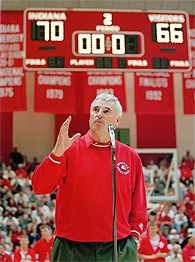Remembering a time when a man defined an institution
 Somewhere in my father’s attic or basement, resting assumedly under my old Legos or a bevy of rusted tools, you will find one of a pair of box-framed pictures. They bear the likeness of a man I’m told is quite imposing in person, tall and broad. But in these pictures, he’s simply a tough face, frozen in action, stalking the sideline of an unrecognizable arena.
Somewhere in my father’s attic or basement, resting assumedly under my old Legos or a bevy of rusted tools, you will find one of a pair of box-framed pictures. They bear the likeness of a man I’m told is quite imposing in person, tall and broad. But in these pictures, he’s simply a tough face, frozen in action, stalking the sideline of an unrecognizable arena.
According to the Sharpie-written signature on the glossy front, the man is Bob Knight. Perhaps you know him?
This requires backstory: Growing up, I played church league basketball and indoor soccer, and I don’t believe there was a season in either during which I did not call my father “coach.” In basketball, in particular, he was very defense-first, which explains the reverence of Knight. And so it was that I came to know the man known as “the General,” from the man every son listens to most.
He was a tough coach, but a fair coach. He preached discipline, defense and respect — all the sorts of things a father teaches a son, or tries to. I’d like to think at least some of it took.
What didn’t take, in a manner of speaking, was what existed behind Knight, beyond him. I saw the man, and I saw his signature, and I tried to live his commandments, relayed to me through my father. But I had no idea where that sideline was. I wasn’t much more sure of where Indiana was, beyond the fact that my father’s late father was raised in Seymour. I hadn’t the foggiest idea Knight coached at Indiana, much less what had been accomplished there not through that man on my bedroom wall.
All I knew was Knight — his toughness, and his willingness, apparently, to answer a thankful letter with a pair of signed pictures and a short letter.
It’s odd to think that, to parts of the country where basketball wasn’t king, (college football rules) that’s what Indiana basketball was: simply a vehicle through which the public got to ingest more Bob Knight. The good, the bad and the ugly of the winningest coach in Division I history, that’s what so many people saw when they watched Indiana basketball. Not the Hoosiers, not the winning or the losing or the automatic All-Americans, but Bob Knight.
Was that a good thing? I don’t know. Was it a bad thing? I don’t know. It was what it was, I guess, and how Knight was ingested probably determined that.
And I’m surely not wrong in assuming someone from Seattle with the same background on Knight and Indiana would say something completely different. But even the most diehard Indiana fans would probably admit that, until that fateful day in the late summer of 2000, Indiana was Bob Knight, and not quite vice-versa.
Today marks the 10-year anniversary of the man’s unceremonious firing from the university, a day still jammed unpleasantly in the memories of many Hoosier fans. And with the exception of a run to the national title game soon after his departure, those 10 years have been largely forgettable. Between Mike Davis’ shortcomings and Kelvin Sampson’s foolish failure, Indiana basketball has spent the better part of the last decade looking rather rudderless.
Such was the impact of Knight, a man whose specter loomed large over IU Athletics for 28 years. Those in the know will even tell you Indiana still hasn’t quite escaped that shadow, after all this time.
Has Indiana basketball suffered because of the way Knight was amputated from the program? Was all this turmoil born, at least in part, of not having the man who became a sort of talisman for the program he now publicly refuses? As someone who saw Indiana basketball not through Knight, but as Knight, basically until I came to campus, I would be inclined to say yes.
But that’s changing now. Where Mike Davis was too private, and Kelvin Sampson too surly, (or maybe not surly enough, considering his predecessors) Tom Crean has played the part considerably well since his time in Bloomington. In addition to his basketball bonafides, Crean had a strong reputation for an ability to take up a sort of figurehead position, rallying the troops — if you will — both on the court and in other public forums. What Knight once was, Crean is slowly becoming, without the temper, obviously.
It will obviously take time, which Crean has, and wins, which Crean should start rolling in more of this year. Maybe then — perhaps only then — will Indiana stop simply being “that placed where the angry man used to coach.” The program, and even the entire department, can emerge from this Knight-sized shadow, and forge a different path to the future.
Filed to: Bob Knight
